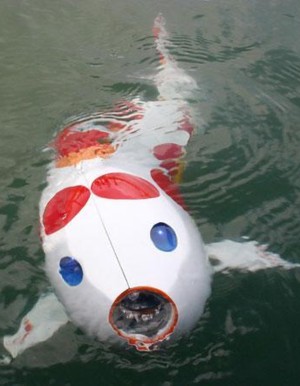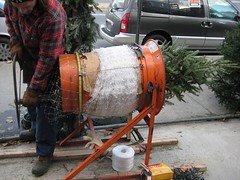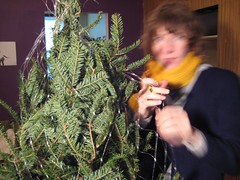Part 2 of 2: In Which I Quote Some Famous People
Let’s return, though, for a moment to my morbid preoccupation with the-fish-as-memento-mori.
While visiting Chicago last summer, I spent a fair amount of time talking to Kei and Mordecai about
Nintendo’s Animal Crossings. The main point of this game is to live peaceably in a virtual world of talking animals. This involves routine repetition of several commonplace tasks, such as shopping, collecting acorns, and walking through the forest.
Additionally, you can capture approximately 40 different kinds of fish. Because the game plays out in real time and certain fish are intentionally elusive, one must plan one’s fishing expeditions according to weather, date, and season if one wishes a complete collection. There is also a social aspect to the game, as its title suggests, and one can converse and correspond with one’s creaturely neighbors, as well as visit their homes. After about a year of game play, Kei told me, some of her oldest neighbors had begun to exhibit bizarre behavior, slowly selling off their furniture and replacing it with fish tanks.
“All they talk about is fish,” said Kei, “No one knows why.”
If we were to ask Roland Barthes, incessant interpreter of signs and eternal pervert, about this preponderance of fish, he might respond that it is but one more indicator pointing towards the inherent emptiness of Japanese culture. This happens to be exactly what he says about fish as a subset of Japanese cuisine in
Empire of Signs. Despite the fact that carp are used to represent strength and vitality in the “
Tango-no-Sekko,” or annual “Boy’s Festival,” for Barthes, the “soggy, fibrous, elastic, compact, rough, slippery” fish is a purely “interstitial object.” A foodstuff comprising “the dream of a paradox,” offering nothingness as nourishment to a people devoid of central essence.
Yes, yes, yes, one might understandably argue, but fish is not nothing and, moreover, it’s delicious! Well, this protest leads to its own set of problems, as W.G. Sebald outlines in his elegantly haunting meditation on destruction,
The Rings of Saturn.

In his chapter on the drastic decline of the North Sea herring population, Sebald tells of a time in the 19th Century when “untold millions of herring [rose] from the lightless depths in the spring and summer months, to spawn in coastal waters and shallows, where they [lay] one on top of another in layers.” At its peak, he tells us, the fishing industry pulled something close to 60 billion herring from the sea per year. He then contemplates whether fish can truly feel and specifically whether they feel in those crucial moments between capture and death:
Given these quantities, the natural historians sought consolation in the idea that humanity was responsible for only a fraction of the endless destruction wrought in the cycle of life, and moreover in the assumption that the peculiar physiology of the fish left them free of the fear and pains that rack the bodies and souls of higher animals in their death throes. But the truth is that we do not know what the herring feels. All we know is that its internal structure is extremely intricate and consists of more than two hundred different bones and cartilages. Among the herring’s most striking external features are its powerful tail fin, the narrow head, the slightly prominent lower mandible, and its large eye, with a black pupil swimming in the silvery white iris.Regardless of whether or not the fish feel, Sebald clearly feels for the fish. What follows the above quotation may be the loveliest and most curious passage I've read recently. This I will leave for you to discover or remember while I turn my attention to a less worthy work of fiction, namely Cormac McCarthy’s
The Road.
If we’re Facebook friends, you might know how passionately, viscerally, and venomously I hate this book. Though I read it months ago, thinking about it now still makes me want to throw up— not throw up due to the grotesqueness of McCarthy's imagery, but throw up out of hatred. That, however, is neither here nor there. What matters, at the moment, is how McCarthy ends his post-apocalyptic tale of the inexhaustible depths of human suffering and the futility of hope. He ends it with fish. This is the last paragraph:
Once there were brook trout in the streams in the mountains. You could see them standing in the amber current where the white edges of their fins wimpled softly in the flow. They smelled of moss in your hand. Polished and muscular and torsional. On their backs were vermiculate patterns that were maps of the world in its becoming. Maps and mazes. Of a thing which could not be put back. Not be made right again. In the deep glens where they lived all things were older than man and they hummed of mystery.That’s the end. The fish had secrets that men ruined. The world is awful, so go die. At this point, many readers may automatically think of the famous fish ending of another epic account of disaster and despair:
I sat upon the shore
Fishing, with the arid plains behind me
Shall I at least set my lands in order?Of course, it’s debatable whether the end of Eliot’s “Waste Land” marks an eternal descent into meaninglessness or sets the stage for eventual regeneration. If I could think about it rationally, I suppose that the same arguments might be made for and against optimism in
The Road. But I’m not rational, remember? I look at fish and automatically see death.

For whatever it’s worth, let it be known that my 2007 ended in fish. Who knows what may follow.










